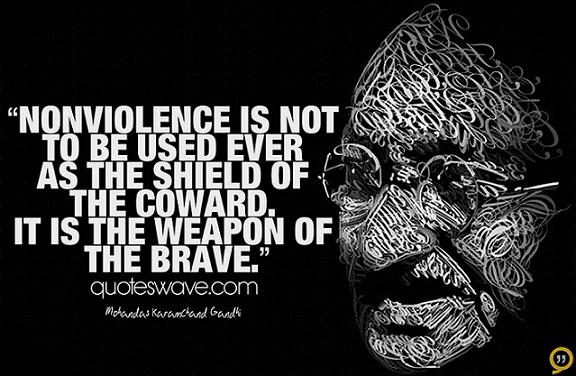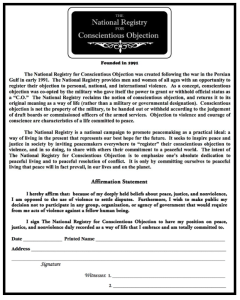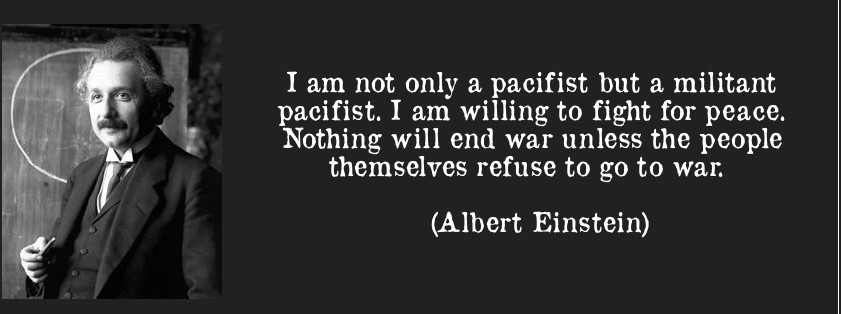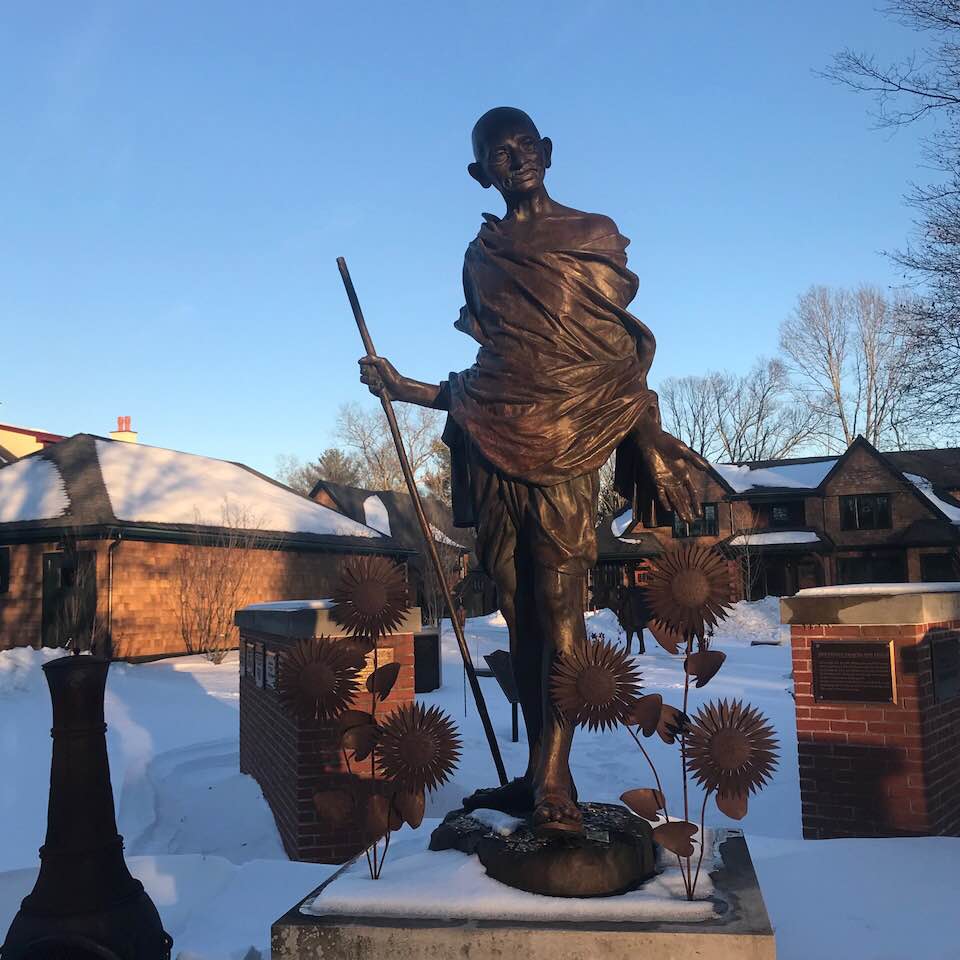Conscientious objection has a unique place in United States history
In fact, the tradition of refusing military service – and the recognition of that right – can be traced back to America’s founding fathers, some of whom were pacifists fleeing oppression for their beliefs in Europe. Several of the original colonies, including Pennsylvania, Delaware and New Jersey, were founded by the Quaker pacifist William Penn.
The framers of the U.S. Constitution even considered including an exemption from military service for conscientious objectors in the Second Amendment. This clause was omitted because they did not envision the need for creating a standing army.
At the onset of the Revolutionary War, George Washington issued a draft order, which was a call to “all young men of suitable age to be drafted, except those with conscientious scruples against war.”
During the American Civil War, the conscription law of the North provided the opportunity for religious objectors and others to buy their way out of the draft. Those who refused or could not afford that option were treated harshly under military law. Four thousand men served in the military as unarmed legal conscientious objectors (COs).
World War I ushered in the first draft since the Civil War, and policies that were even less tolerant of conscientious objectors. Seventeen draft resisters died of mistreatment in Alcatraz Prison during World War I.
In World War II, a total of nearly 43,000 Americans refused to fight for reasons of conscience: 12,000 served in Civilian Public Service, 6,000 went to prison and 25,000 served in the military as noncombatants. During the Vietnam War more than 170,000 men were officially recognized as conscientious objectors. Thousands of other young men resisted by burning their draft cards, serving jail sentences or leaving the country.
Though the military is currently an all-volunteer organization, when the Gulf War broke out in 1991, 2,500 men and women volunteers serving in the Armed Forces refused to serve in Saudi Arabia on the basis of conscience. While draft opposition has been an individual decision made by a minority in all U.S. wars, public opposition to wars such as the War of 1812, the Mexican War, World War I and the Vietnam War sparked mass movements that reached far beyond men of draft age.
Above article from War Resisters League.
Pacifism
There are several different sorts of pacifism, but they all include the idea that war and violence are unjustifiable, and that conflicts should be settled in a peaceful way.
The word (but not the idea) is only a century old, being first used in 1902 at the 10th International Peace Conference.
Era of war pinches a place devoted to peace
SHERBORN — The Peace Abbey, born of a pacifist’s dream 19 years ago, has brought the inner hum of meditation and the occasionally harsh spotlight of international attention to this small, affluent town.
It is a place where a conspicuous bronze statue of Gandhi and a memorial to a runaway cow have prompted double-takes from motorists and passersby. It is also a multifaith retreat that Mother Teresa has visited, as have Muhammad Ali, the poet Maya Angelou, nuns of the Dalai Lama , and thousands of people seeking spiritual refreshment within the context of political engagement and peace activism.
“For its entire existence,” Randa said, the Abbey “has been operating on a wing and a prayer.”.
“Quite frankly, we became increasingly controversial in the eyes of many, and the funding dried up,” he said in an interview in the Abbey.
“I would hate to see them go,” said Selectman Christopher Peck. “I do think they represent the good side of town.”
Not all Sherborn residents have felt so kindly. When the Gandhi statue was erected in 1993, next to a town war memorial, some townspeople complained that the sculpture was an affront to the community’s veterans.
But now, Peck said, he never hears such criticism. “I haven’t heard any negative comments about the statues,” Peck said.
Founded by Randa after a visit by Mother Teresa in 1988, the Abbey has provided a setting filled with symbols and texts from 12 major faiths, including Christianity, Islam, and Zoroastrianism. The Abbey organizes workshops on pacifism, conducts weekly meditation services, and even provides an on-site cemetery for the cremated remains of conscientious objectors.
Five times a day, a Muslim call to prayer sounds for two minutes from the grounds of the Abbey. The tape-recorded call is sung by Yusuf Islam, a convert perhaps better known as the former pop singer Cat Stevens, and can be heard by nearby residents and passersby.
But even in a liberal state like Massachusetts, Randa said, the Abbey’s antiwar work appears directly tied to an evaporation of large contributions to the institution. Ironically, the number of smaller donations, in the form of $5 and $10 contributions has increased.
“If you’re walking the walk and you can’t pay the bills, it’s somebody else’s turn,” Randa said.
Pacifism is opposition to war and violence. The word pacifism was coined by the French peace campaigner Émile Arnaud (1864–1921) and adopted by other peace activists at the tenth Universal Peace Congress in Glasgow in 1901.[1] A related term is ahimsa (to do no harm), which is a core philosophy in Buddhism, Jainism, and Hinduism. While modern connotations are recent, having been explicated since the 19th century, ancient references abound.
In Christianity, Jesus Christ‘s injunction to “love your enemies” and asking for forgiveness for his crucifiers “for they know not what they do” have been interpreted as calling for pacifism. In modern times, interest was revived by Leo Tolstoy in his late works, particularly in The Kingdom of God Is Within You. Mohandas Gandhi (1869–1948) propounded the practice of steadfast nonviolent opposition which he called “satyagraha“, instrumental in its role in the Indian Independence Movement. Its effectiveness served as inspiration to Martin Luther King Jr., James Lawson, James Bevel,[2] Thich Nhat Hanh[3] and many others in the 1950s and 1960s American Civil Rights Movement. Pacifism was widely associated with the much publicized image of Tiananmen Square Protests of 1989 with the “Tank Man“, where one protester stood in nonviolent opposition to a column of tanks.
Pacifism covers a spectrum of views, including the belief that international disputes can and should be peacefully resolved, calls for the abolition of the institutions of the military and war, opposition to any organization of society through governmental force (anarchist or libertarian pacifism), rejection of the use of physical violence to obtain political, economic or social goals, the obliteration of force, and opposition to violence under any circumstance, even defence of self and others. Historians of pacifism Peter Brock and Thomas Paul Socknat define pacifism “in the sense generally accepted in English-speaking areas” as “an unconditional rejection of all forms of warfare”.[4] Philosopher Jenny Teichman defines the main form of pacifism as “anti-warism”, the rejection of all forms of warfare.[5] Teichman’s beliefs have been summarized by Brian Orend as “…A pacifist rejects war and believes there are no moral grounds which can justify resorting to war. War, for the pacifist, is always wrong.” In a sense the philosophy is based on the idea that the ends do not justify the means.[6]
NATIONAL REGISTRY FOR CONSCIENTIOUS OBJECTION
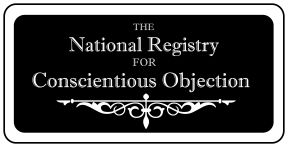
Are you a Conscientious Objector or thinking of becoming one?
Download this packet for COs to learn more about how to get involved in the peace movement and read up on the history of Conscientious Objection in the United States.
Interested in bringing the National Registry for Conscientious Objection to your University, Campus group, or Community Organization? Download this packet for organizers to learn how to get a National Registry for Conscientious Objection for your organization. Along with the continuous addition of registries amongst college campuses in the United States, we are also working on outreach to high school students. If you are a parent, educator, or student and are interested in working on promoting nonviolent lifestyles for youth, request that the Registry be brought to your school.
If you are thinking of bringing the registry to your organization or have questions about becoming a CO, please contact the Peace Abbey at
The National Registry for Conscientious Objection was created at The Peace Abbey following the war in the Persian Gulf in early 1991. The National Registry provides men and women of all ages with an opportunity to register their objection to personal, national, and international violence.
As a concept, conscientious objection was co-opted by the military who gave itself the power to grant or withhold official status as a “C.O.” The National Registry reclaims the notion of conscientious objection and returns it to its original meaning as a way of life (rather than a military or governmental designation). Conscientious objection is not the property of generals, to be handed out or withheld according to the judgment of draft boards. Objection to violence and courage of conscience are characteristics of a life committed to peace.
The National Registry is a national campaign to promote peacemaking as a practical ideal: a way of living in the present that represents our best hope for the future. It seeks to inspire peace and justice in society by inviting peacemakers everywhere to “register” their conscientious objection to violence, and in so doing, to share with others their commitment to a peaceful world.
The intent of The National Registry for Conscientious Objection is to emphasize one’s absolute dedication to peaceful living and to the peaceful resolution of conflict. It is only by striving for perfection that we approach perfection. Likewise, it is only by committing ourselves absolutely to peaceful living that peace will, in fact, prevail, in our lives and on the planet.
Signing the Registry
We welcome you to The Peace Abbey to sign The National Registry for Conscientious Objection in person and join us in this initiative for peace. Or you can print the National Registry form below and send the signed original back to The Peace Abbey, 8 Town Square, Plymouth, MA 02360. We encourage you to keep a copy for your personal records, perhaps framed and displayed as a sign of your commitment to peace.
ATTENTION:
PLEASE INCLUDE YOUR EMAIL ADDRESS ON THE ABOVE FORM.
NEW MAILING ADDRESS FOR SUBMISSION OF SIGNED CO FORM:
THE PEACE ABBEY FOUNDATION
8 Town Square
Plymouth, MA 02360
THE REPORTER for Conscience’ Sake
It is fitting that the pacifist be bold in the knowledge that he or she (however unworthy) is with the prophets, and his or her inquisitors (however worthy) are speaking for the dead past out of which humankind is creeping. It is not right that the advocates of love should apologize or flinch.
-Handbook for Conscientious Objectors Eighth Edition, 1965
Glossary of Nonviolence
AGAPE – Overflowing unconditional love for all, including adversaries, needed for nonviolent conflict-resolution. Dr. King called it “love in action…love seeking to preserve and create community…love which is purely spontaneous, unmotivated, groundless and creative.”
AHIMSA – The Hindi word for non-injury, or nonviolence made popular by Gandhi as the central value of his beliefs and leadership.
ARBITRATION – Hearing of a dispute and determining its outcome by a mutually-agreed-upon third party. Can be binding or non-binding.
BELOVED COMMUNITY – Term coined by philosopher Josiah Royce to denote an ideal community, used frequently by Dr. King to describe a society of justice, peace and harmony which can be achieved through nonviolence. In his sermon at Dexter Avenue Baptist Church in Montgomery, Alabama, on April 2, 1957, Dr. King said, “The aftermath of nonviolence is the creation of the beloved community.”
BOYCOTT – A campaign of withdrawal of support from a company, government or institution which is committing an injustice, such as racial discrimination. As Dr. King said, “There is nothing quite so effective as the refusal to cooperate with the forces and institutions which perpetuate evil in our communities.”
CIVIL DISOBEDIENCE – The act of openly disobeying an unjust, immoral or unconstitutional law as a matter of conscience, and accepting the consequences, including submitting to imprisonment if necessary, to protest an injustice.
CONFLICT RESOLUTION – Ending of conflict, disputes or disagreements by nonviolent means with intent to achieve a “win-win” outcome for all parties.
CONSCIENTIOUS OBJECTION – A refusal to participate in military service because of moral beliefs.
CREATIVE TENSION – In his Letter from A Birmingham Jail, Dr. King said, “Nonviolent direct action seeks to create such a crisis and establish such creative tension that a community that has constantly refused to negotiate is forced to confront the issue…I must confess that I am not afraid of the word, tension. I have earnestly worked and preached against violent tension, but there is a type of constructive tension that is necessary for growth… the purpose of direct action is to create a situation so crisis-packed that it will inevitably open the door to negotiation.”
DEMONSTRATIONS – Gatherings and protest activities organized to build support for peace, justice or social reform.
DIRECT ACTION – Nonviolent resistance to injustice. More than 250 forms of nonviolent direct action have been identified, including marches, boycotts, picketing, sit-ins and prayer vigils, to name a few. See Six steps of nonviolence.
FASTING – Refusing to eat as a method of self-purification to be spiritually strengthened for nonviolent action, or as a protest.
GANDHI, MOHANDAS K. – (1869—1948) Leader of India’s nonviolent independence movement, who forced the British to quit India. Dr. King studied Gandhi’s successful campaigns and adapted some of Gandhi’s strategies in the American Civil Rights Movement. As Dr. King said of the role of Gandhi’s teachings in the Civil Rights Movement, “Christ furnished the spirit and motivation, while Gandhi furnished the method.” Dr. King said “Gandhi was the guiding light of our technique for nonviolent social change.”
LAWS, JUST VS. UNJUST – A distinction made in deciding to engage in civil disobedience. A just law is created by both a majority and minority, and is binding on both. An unjust law is created by a majority that is binding on the minority, when the minority has no voice in creating the law. Dr. King said, “A just law is a man-made code that squares with moral law or the law of God. An unjust law is a code that is out of harmony with moral law…One who breaks an unjust law must do so openly, lovingly and with a willingness to accept the penalty.”
MASS MARCH – A large number of people walk in a group to a place of symbolic significance to protest an injustice.
MEDIATION – intervention in a dispute by a neutral third party with expertise on a particular issue for the purpose of securing a compromise, an agreement or reconciliation. A mediator can not impose a binding agreement.
MORAL SUASION – Appealing to the moral beliefs of an adversary or the public to convince the adversary to change behavior or attitudes.
NEGOTIATION – Process of discussing, compromising and bargaining with adversaries in good faith to secure a resolution to a conflict and reconciliation of adversaries. (See six steps of nonviolence below)
NONCOOPERATION – Refusal to participate in activities of or cooperate with individuals, governments, institutions, policies or laws that result in violence or injustice.
PACIFISM – A philosophy based on an absolute refusal to engage in violence because it is morally wrong.
PASSIVE RESISTANCE – Challenging an injustice by refusing to support or cooperate with an unjust law, action or policy. The term “passive” is misleading because passive resistance includes pro-active nonviolence, such as marches, boycotts and other forms of active protest.
PERSONAL COMMITMENT – The spiritual and psychological decision to participate in nonviolent action to eliminate an injustice. Prayer, meditation and sometimes fasting are used to deepen one’s spiritual understanding.
PETITION CAMPAIGNS – gathering of massive numbers of signatures in support of or opposed to a policy, proposal or law.
PICKETING – A group of individuals walk with signs bearing protest messages in front of a site where an injustice has been committed.
PURIFICATION – The cleansing of anger, selfishness and violent attitudes from the heart and soul in preparation for a nonviolent struggle. (See six steps of nonviolence below)
RECONCILIATION – The end goal of nonviolence. Bringing together of adversaries in a spirit of community after a conflict has been resolved. (See six steps of nonviolence below)
REDEMPTIVE SUFFERING – A willingness to accept suffering without seeking revenge or retribution. When an individual or group experiences injustice and abuse for a good cause, it will help produce a greater good.
SATYAGRAHA – Hindi for “soul force,” a term coined by Gandhi to emphasize the power of unadorned truth and love in a social struggle
SAVING FACE – Offering an adversary an alternative course of action which spares him or her embarrassment.
SELECTIVE PATRONAGE – The flip side of a boycott. Making a point of purchasing a product or service from a company that supports justice.
SIT-INS – Tactic of nonviolence in which protesters sit down at the site of an injustice and refuse to move for a specified period of time or until goals are achieved. Examples include Flint (Mich.) sit-down strike of 1936-37 in which auto workers sat down on job for 44 days in protest for union recognition and the student sit-ins to desegregate lunch counters in Greensboro, N.C. in 1960.
STOCKHOLDERS CAMPAIGN – Individuals or groups purchases a small amount of stock so they can have introduce resolutions at stockholder meetings, vote as stockholders and lobby corporations to correct an injustice.
STRIKES – Organized withholding of labor to correct injustice.
TEACH-INS – An organized event or series of events, including public hearings, lectures, panel discussions, theatrical presentations, showing of films, role-playing and scenario exercises and other educational techniques, to inform public about a particular issue.
TRADE SANCTIONS – A nation levies import taxes on products from another nation, or bans importation of a nation’s products altogether.
VIGILS – A form of protest in which individuals and groups stand, sit, walk, or pray at a site linked to an injustice or symbolically associated with principles of freedom, justice or peace.
– See more at: http://www.thekingcenter.org
